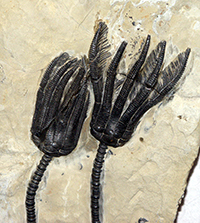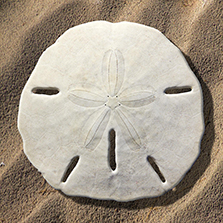
The hard parts are built from a form of calcium carbonate called "Calcite." Crinoid stems are common fossils in Tennessee, although they are sometimes mistaken for fossilized worms, or called "Indian money" because they break apart into coin-like cylinders. Because this cylinder was broken at a diagonal angle, it has an oval appearance that at first glance makes it resemble a human eye. |
|
Taking another look at our fossil, we can see that it appears to be built from a stack of flat disks. The outer parts had a spiculated matrix that has dissolved, leaving an inner layer of calcite sometimes surrounding a center hole that can have a pentagon shape. That five-sided structure resists kinking while still allowing an element of flexibility, and identifies it as an echinoderm.
An interesting fact about echinoderms is that they follow embryonic development pathways that classify them as deuterostomes -- linking them to vertebrate animals like humans. This suggests that starfish, sand dollars and crinoids could be part of our own evolutionary line -- unlike worms, clams, insects or crustaceans which are protostomes.
So our mystery fossil turns out to be one of our own cousins-- a remote and unfamiliar ancestor, entombed in rock long ago. Thanks Wanda for sending in this interesting fossil! |
|
 The sand dollar is another familiar five-sided echinoderm that we might find on a modern beach. The sand dollar is another familiar five-sided echinoderm that we might find on a modern beach.

|